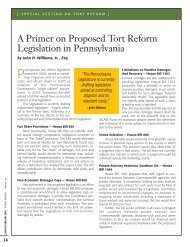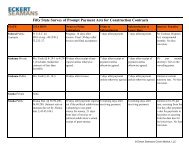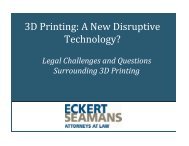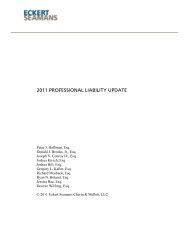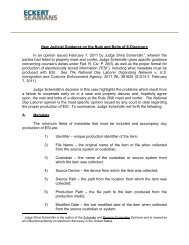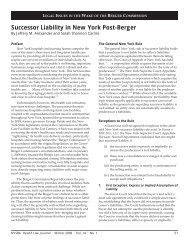not be set aside. On July 7, 2005, the Court granted the motion to set aside the agreementand subjected the plaintiff’s assets to an equitable distribution hearing. On July 28, 2006,the plaintiff met with defendant Downey to discuss a legal malpractice action against theConnelly defendants. On October 26, 2006, Downey sent a letter to the Connellydefendants indicating they committed malpractice, informing the Connelly defendants toinform their insurance carrier, and stating the statute of limitations began to run on July 7,2005, the date of the judge’s order. On March 30, 2007, the plaintiff signed an officialagreement to file suit, but Downey did not file the lawsuit. On February 25, 2008, Downeysent the plaintiff a letter terminating the representation because the two-year statute oflimitations began to run on August 2, 2004, the date of the hearing, and, therefore, itexpired on August 2, 2006, before the plaintiff met with Downey. The plaintiff filed suit onJuly 6, 2009 against the Connelly defendants and against Downey alleging legalmalpractice. Downey filed a motion for summary judgment alleging the statute oflimitations barred any cause of action against the Connelly defendants, and, therefore, thelegal malpractice claim against Downey failed as a matter of law. The district courtapplied the occurrence rule, and found the claim barred by the statute of limitation, whichbegan to run on August 2, 2004, the date of the hearing. The Third Circuit reversed,finding the discovery rule applied and the statute of limitations did not begin to run untilJuly 7, 2005, the date of the order.The court noted that “under the occurrence rule, ‘the statutory period commencesupon the happening of the alleged breach of duty.’” Knopick, 639 F.3d at 607 (citingWachovia Bank N.A. v. Ferretti, 935 A.2d 565, 572 (Pa. Super. Ct. 2007)). “Where aplaintiff could not reasonably have discovered his injury or its cause, however,Pennsylvania courts have applied the discovery rule to toll the statute of limitations.” Id.(citing Wachovia, 935 A.2d at 572–74). If the discovery rule applies, the statute oflimitations begins to run when the plaintiff knew or in the exercise of reasonable diligenceshould have known of the injury and its cause. Id. (citing Crouse v. Cyclops Indus., 745A.2d 606, 611 (2000)). The court noted the discovery rule is “grounded on considerationsof basic fairness.” Id. (quoting Taylor v. Tukanowicz, 435 A.2d 181, 183 (1981)).The court outlined cases in which the discovery rule applied, including medicalmalpractice claims. It noted the principle for the discovery rule’s applicability in medicalmalpractice claims, i.e., that the plaintiff is not held responsible for knowing of an injuryuntil the abnormal condition manifests itself, is applicable in the context of legalmalpractice. Id. at 609. The court noted Pennsylvania courts and federal courts applyingPennsylvania law have applied the discovery rule to legal malpractice causes of action. Id.Courts apply the discovery rule where “the injured party is unable, despite the exercise ofdue diligence, to know of his injury or its cause.” Id. It is applied where requiring theplaintiff’s knowledge would be unreasonable and it tolls the statute until the plaintiff is putin a position to discover the injury or its cause. The court noted knowledge can be imputedwhere an adverse action is taken against the plaintiff.The court noted the Pennsylvania Supreme Court has not addressed the discoveryrule’s applicability to legal malpractice actions in a civil suit. It analyzed the PennsylvaniaSuperior Court decisions discussing the rule’s applicability in the civil context as well as162
the Pennsylvania Supreme Court’s discussion of the discovery rule in medical malpracticecases.The court noted that “[o]f critical importance in this case is the distinction betweenthe act constituting the alleged breach—the Connelly Defendants’ failure to call witnesses,which would start the statute under the occurrence rule—and the injury that flowed fromthis failure, constructive knowledge of which would trigger the statute of limitations underthe discovery rule.” Id. at 615. The court found, although it is undisputed the plaintiffknew the witnesses were not called, “it remains in dispute, and a question . . . a jury shoulddecide, when [the plaintiff] knew that he was injured as a result of the witnesses not beingcalled.” The court concluded “reasonable minds could disagree in determining whetherKnopick knew or should have known, through the exercise of reasonable diligence, of hisalleged injury as early as August 2, 2004, the date of the hearing.” Id. at 616.K. Contributory Negligence DefenseIn KBF Associates L.P. v. Saul Ewing Remick & Saul, 35 Pa. D. & C. 4th 1 (Phila. Cty.Ct. Com. Pl. 1998), the court, per Judge Bernstein, held that contributory negligence is not aviable defense in a legal malpractice action. In KBF, Plaintiff-client alleged that Defendant lawfirm was negligent in failing to advise them of a late fee incurred by the postponement of a bondredemption, which was part of a larger and complex bond reoffering transaction. Defendant lawfirm asked the court “to rule that a client may be barred from suing his attorney for malpracticewith respect to errors within the scope of the attorney’s engagement where it can bedemonstrated that the client had the capability and expertise to have independently determinedthe error.” Id. at 3. The court found no support in Pennsylvania law for such a proposition andsoundly rejected it. Citing cases from other jurisdictions, the court reasoned as follows:Id. at 5, 7-8.[T]he [instant] legal malpractice action cannot be defended on thebasis of contributory negligence upon the allegation that the clientitself was sophisticated enough to do its own legal work andcorrect the error.* * *The Plaintiff had a right to rely on the advice of experienced bondcounsel without the risk that the consequences of Defendants’negligence would be shifted to the partnership because of thesophistication or experience of its general partner. . . Counsel maynot shift to the client the legal responsibility it was specificallyhired to undertake because of its superior knowledge.However, in Gorski v. Smith, et al., 812 A.2d 683 (Pa. Super. Ct. 2002), appeal denied,856 A.2d 834 (Pa. 2004), the Pennsylvania Superior Court adopted the rule that the negligence ofa client may be raised as an affirmative defense by an attorney in a legal malpractice action thatis based on a theory of negligence. The client’s negligence, once proven, will serve as a163
- Page 3 and 4:
EMTALA CASES ......................
- Page 5:
Filing an Affidavit of Non-Involvem
- Page 8 and 9:
II.PROFESSIONAL LIABILITY - AN OVER
- Page 10 and 11:
The Superior Court reversed the tri
- Page 12 and 13:
to a third party pursuant to the st
- Page 14 and 15:
After approximately five months, De
- Page 16 and 17:
learned the day after the surgery t
- Page 18 and 19:
conduct to the delay in colon cance
- Page 20 and 21:
court admitted the expert’s testi
- Page 22 and 23:
(b)(c)other reasonable causes, incl
- Page 24 and 25:
corroborated his testimony. The cou
- Page 26 and 27:
husband’s estate. Plaintiff alleg
- Page 28 and 29:
Other notable federal cases arising
- Page 30 and 31:
The Superior Court found that in re
- Page 32 and 33:
§ 1303.512(b). The court, however,
- Page 34 and 35:
In Neidig v. United States, No. 07-
- Page 36 and 37:
Additionally, the Supreme Court not
- Page 38 and 39:
were not indicated for her conditio
- Page 40 and 41:
surgeon is the same as it would be
- Page 42 and 43:
It should be noted that the Superio
- Page 44 and 45:
Finally, the court held that the tr
- Page 46 and 47:
The Supreme Court of Pennsylvania r
- Page 48 and 49:
nurses deviating from applicable st
- Page 50 and 51:
certainty, the court reviews expert
- Page 52 and 53:
Under Pennsylvania law, the Court n
- Page 54 and 55:
testimony, Defendant presented his
- Page 56 and 57:
Following Cooper v. Roberts, 286 A.
- Page 58 and 59:
Plaintiff developed chronic diarrhe
- Page 60 and 61:
where payment is made by Medicaid w
- Page 62 and 63:
accomplished. In Valles v. Albert E
- Page 64 and 65:
In 1980, the Pennsylvania Superior
- Page 66 and 67:
Plaintiff had a routine monitoring
- Page 68 and 69:
Plaintiff’s Contract ClaimsThe Co
- Page 70 and 71:
is a failure to report changes in a
- Page 72 and 73:
unit to assure post-surgical patien
- Page 74 and 75:
sliced his wrist and arm with a raz
- Page 76 and 77:
licensed professionals for whom the
- Page 78 and 79:
(c)Limitations of Corporate Neglige
- Page 80 and 81:
Even more recently, our Superior Co
- Page 82 and 83:
(a)HMO IssuesIn McClellan v. Health
- Page 84 and 85:
affidavit submitted by Defendants o
- Page 86 and 87:
treatments while at VA’s faciliti
- Page 88 and 89:
[s]ubstantively, we believe that a
- Page 90 and 91:
The party claiming the benefit of t
- Page 92 and 93:
deprive (him) of civil rights guara
- Page 94 and 95:
found that the District Court was w
- Page 96 and 97:
With respect to fraudulent concealm
- Page 98 and 99:
would be applied in situations wher
- Page 100 and 101:
they had not raised them in the cou
- Page 102 and 103:
(a)Informed ConsentUnder MCARE, a p
- Page 104 and 105:
civil enforcement provisions and ma
- Page 106 and 107:
MCARE also changes the manner in wh
- Page 108 and 109:
whose death, in 2005, was allegedly
- Page 110 and 111:
vicariously liable if the plaintiff
- Page 112 and 113:
health center or its equivalent or
- Page 114 and 115:
In Pennsylvania Medical Society, th
- Page 116 and 117:
to any professional who is alleged
- Page 118 and 119: Since the 2005 amendments, there ha
- Page 120 and 121: ule, but who intentionally ignores
- Page 122 and 123: the original Complaint was delivere
- Page 124 and 125: foreclose all challenges against th
- Page 126 and 127: number of boxes), which was support
- Page 128 and 129: questions of professional judgment
- Page 130 and 131: deviated from any professional stan
- Page 132 and 133: The Third Circuit affirmed the Dist
- Page 134 and 135: claims and cross-claims remain agai
- Page 136 and 137: By an Amendatory Order dated March
- Page 138 and 139: The court acknowledged that there i
- Page 140 and 141: apply and that the trial court misa
- Page 142 and 143: Barbados had enough litigation-spec
- Page 144 and 145: E. Preemption of Vaccine Design Def
- Page 146 and 147: 2. Pa. R. Civ. Pro. 1036.1 - Reinst
- Page 148 and 149: Barrick, at *34-35.Furthermore, the
- Page 150 and 151: (b) the utility of the defendant’
- Page 152 and 153: 2006). In this case, Plaintiffs bro
- Page 154 and 155: B. Elements of a Cause of Action fo
- Page 156 and 157: decision in Muhammad precluded Mr.
- Page 158 and 159: considered speculative “only if t
- Page 160 and 161: underlying cause of action involved
- Page 162 and 163: In Capital Care Corp., the Superior
- Page 164 and 165: The court found, however, to state
- Page 166 and 167: of reasonable diligence. The standa
- Page 170 and 171: complete bar to recovery. Since a l
- Page 172 and 173: On appeal, Plaintiffs claimed that
- Page 174 and 175: In Liggon-Redding, 659 F.3d at 265,
- Page 176 and 177: elieved of those minimum standards
- Page 178 and 179: elevant to the proceedings, the com
- Page 180 and 181: establish professional misconduct b
- Page 182 and 183: Upholding the Superior Court’s Or
- Page 184 and 185: Id.Rejecting revocation and suspens
- Page 186 and 187: order as a sanction under Rule 4019
- Page 188: {1009912]182



